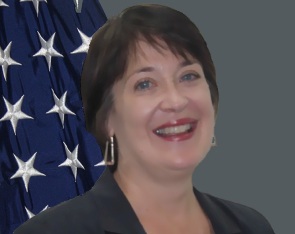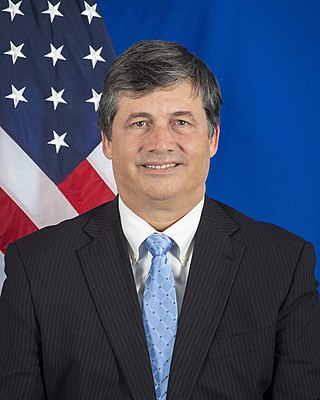
The United States Department of State (DOS), or simply the State Department, is an executive department of the U.S. federal government responsible for the country's foreign policy and relations. Equivalent to the ministry of foreign affairs of other nations, its primary duties are advising the U.S. president on international relations, administering diplomatic missions, negotiating international treaties and agreements, and representing the U.S. at the United Nations. The department is headquartered in the Harry S Truman Building, a few blocks from the White House, in the Foggy Bottom neighborhood of Washington, D.C.; "Foggy Bottom" is thus sometimes used as a metonym.
Japanese foreign policy toward Southeast Asia, the diverse region stretching from South Asia to the islands in the South Pacific Ocean, was in part defined by Japan's rapid rise in the 1980s as the dominant economic power in Asia. The decline in East-West and Sino-Soviet tensions during the 1980s suggested that economic rather than military power would determine regional leadership. During the decade, Japan displaced the United States as the largest provider of new business investment and economic aid in the region, although the United States market remained a major source of Asia-Pacific dynamism.

The United States under secretary of defense for policy (USDP) is a high level civilian official in the United States Department of Defense. The under secretary of defense for policy is the principal staff assistant and adviser to both the secretary of defense and the deputy secretary of defense for all matters concerning the formation of national security and defense policy.

In the United States Government, the Bureau of European and Eurasian Affairs (EUR) is part of the United States Department of State, charged with implementing U.S. foreign policy and promoting U.S. interests in Europe and Eurasia, as well as advising the Under Secretary of State for Political Affairs. It is headed by the Assistant Secretary of State for European and Eurasian Affairs.

In the United States government, the Bureau of Western Hemisphere Affairs (WHA) is a part of the U.S. Department of State, charged with implementing U.S. foreign policy and promoting U.S. interests in the Western Hemisphere, as well as advising the Under Secretary of State for Political Affairs. It is headed by the Assistant Secretary of State for Western Hemisphere Affairs, who is currently Brian A. Nichols.

The Bureau of South and Central Asian Affairs (SCA) is an agency within the United States Department of State that is responsible for the U.S. government's relations with countries in the South and Central Asian region. The bureau is headed by the Assistant Secretary of State for South and Central Asian Affairs, who reports to the Secretary of State through the Under Secretary of State for Political Affairs. The current Assistant Secretary is Donald Lu, incumbent since September 15, 2021.

The Bureau of Near Eastern Affairs (NEA), also known as the Bureau of Near East Asian Affairs, is an agency of the Department of State within the United States government that deals with U.S. foreign policy and diplomatic relations with the nations of the Near East. It is headed by the Assistant Secretary of State for Near Eastern Affairs, who reports to the Under Secretary of State for Political Affairs.

The Department of Foreign Affairs is the executive department of the Philippine government tasked to contribute to the enhancement of national security, protection of the territorial integrity and national sovereignty, to participate in the national endeavor of sustaining development and enhancing the Philippines' competitive edge, to protect the rights and promote the welfare of Filipinos overseas and to mobilize them as partners in national development, to project a positive image of the Philippines, and to increase international understanding of Philippine culture for mutually-beneficial relations with other countries.

The Ministry of Foreign Affairs, abbreviated KLN, is a ministry of the Government of Malaysia that is responsible for foreign affairs, Malaysian diaspora, foreigners in Malaysia, diplomacy, foreign relations, counter terrorism, bilateral affairs, multilateral affairs, ASEAN, international protocol, consular services, maritime affairs, and chemical weapons. It is currently based in Putrajaya. It is also widely known as Wisma Putra, which is also the name of its building in Putrajaya.
U.S. President Barack Obama's East Asia Strategy (2009–2017), also known as the Pivot to Asia, represented a significant shift in the foreign policy of the United States since the 2010s. It shifted the country's focus away from the Middle Eastern and European sphere and allowed it to invest heavily and build relationships in East Asian and Southeast Asian countries, especially countries which are in close proximity to the People's Republic of China (PRC) either economically, geographically or politically to counter its rise as a rival superpower.

The Ministry of Foreign Affairs of the Republic of Indonesia or commonly known by its abbreviation Kemlu, is an Indonesian government ministry responsible for the country's foreign politics and diplomacy. The ministry was formerly known as the Department of Foreign Affairs until 2008 when the nomenclature changed with the enactment of the 2008 State Ministry Act.

The Assistant Secretary of Defense for Indo-Pacific Security Affairs, or ASD (IPSA), is the principal advisor to the Under Secretary of Defense for Policy (USD(P)) and the Secretary of Defense on international security strategy and policy on issues of DoD interest that relate to the governments and defense establishments of the nations and international organizations within the Indo-Pacific region. It primarily includes the entire region from India to Japan, and the region where ASEAN is located. The position was originally titled Assistant Secretary of Defense for Asian and Pacific Security Affairs but was renamed by the Trump Administration alongside the renaming of the United States Indo-Pacific Command.

Scot Alan Marciel is an American diplomat and served as Principal Deputy Assistant Secretary in the Bureau of East Asian and Pacific Affairs until February 2016. He was confirmed by the U.S. Senate to be the United States Ambassador to Burma on January 28, 2016.

Joseph Yuosang Yun is the former U.S. Special Presidential Envoy for Compact Negotiations, appointed in March 2022 by President Joe Biden to negotiate amendments to the Compact of Free Association (COFA), the agreement governing the relationship between the United States and the Freely Associated States (FAS) of the Federated States of Micronesia, the Republic of the Marshall Islands, and Palau.

The Bureau of Energy Resources (ENR) is a bureau in the United States Department of State that coordinates the department's efforts in promoting international energy security. Under the purview of the Under Secretary of State for Economic Growth, Energy, and the Environment. the Bureau of Energy Resources' current head is Assistant Secretary Geoffrey R. Pyatt.

Nina Lucine Hachigian is the first United States Special Representative for City and State Diplomacy under U.S. Secretary of State Antony Blinken in the Biden administration. In this role, she seeks to bring benefits to, and learn from, local leaders in the US, and connect them to counterparts around the world.

Susan Ashton Thornton is a former American diplomat and former acting Assistant Secretary of State for East Asian and Pacific Affairs.

Susan Lenore Bremner is an American diplomat who served as Chargé d’Affaires ad interim to Eritrea from July 2012 to April 2014., and Chargé d’Affaires ad interim to Chad during her tenure as Deputy chief of mission (DCM) from 2009 to 2011. She was with the State Department for 30 years, serving in Asia, Europe and Africa.

The Office of China Coordination (OCC), informally known as China House, is a unit of the Bureau of East Asian and Pacific Affairs under the U.S. State Department that coordinates information-sharing and policy towards the People's Republic of China.

Mark Baxter Lambert is an American diplomat currently serving as China Coordinator and Deputy Assistant Secretary of State for China and Taiwan in the Bureau of East Asian and Pacific Affairs at the US Department of State, heading the Office of China Coordination and Office of Taiwan Coordination.













